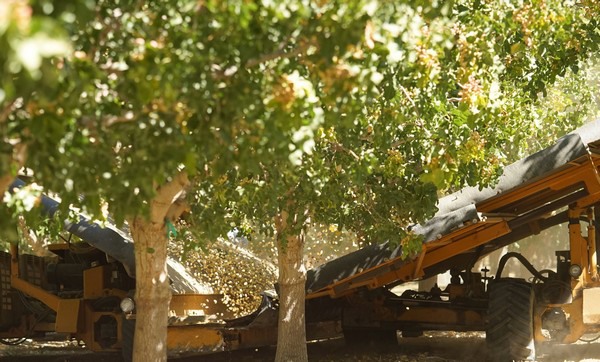Supplies of pistachios are down approximately 20 percent this year--the first crop year since 2018 to not have a record-breaking crop year. “Initially the 2022 crop was expected to be an on-year but it ended up being an off-year,” says Richard Matoian, president of the American Pistachio Growers “That’s probably because 2020 and 2021 both produced record crops consecutively and we think the trees needed a rest. We had about 20 percent less production than originally expected.”
While the harvest started slightly earlier this year, the tremendous summer heat California saw last year did cause the trees to shut down. “So while there was harvest early, there were a lot of orchards that had to wait to be harvested because the fruit wasn’t ripe enough,” he says. In addition, there were a lot of nuts sticking to the trees because of that lack of ripening so while growers generally do two shakes of trees to remove the nuts, many went in for a third shake to get the last fruit off the trees.

Managing carry over
Generally, pistachio production has been growing in California because of the notable number of acres going into the ground. This year’s lower supply also helped minimize the carry-over. “Just prior to harvest in 2022, we came in with our largest carry-over and that was of concern. However, with this short crop, that will go down substantially. If I look at the same time period just before the crop was harvested this year and last year, this year we have 200 million lbs. less in the marketplace to sell,” says Matoian.
Meanwhile, demand continues to be good. North American demand, including Canada and Mexico, has been slowly moving upward. Last year, California pistachio growers also had a good export market, one that was up 24 percent in sales over the year prior. Growing markets for the state include the Middle East, where it may step in with some promotions.
“That seems to be a rising market that traditionally favored Iranian product. Now they are buying more from us,” he says. India, where California growers have been working in the past four to five years to promote pistachios, is also up as is Turkey, a country that does produce its own pistachios but is also buying a sizeable amount of U.S. product. “With all this acreage coming on in California, our work is now focused on finding new or existing markets to promote our product to keep demand strong,” says Matoian.

Firm pricing
As for pricing, given the smaller crop, it’s steady and firm and should stay that way for the rest of the year. “We’ve seen the economy have an effect on the European market. We had buyers that were not purchasing as much early on but in the last couple of months they’ve come back and they are purchasing higher amounts than that same period a year ago. Hopefully, that buying trend will continue,” he says.
Looking ahead at the 2023 crop, it’s already poised to be one of the largest in the state’s history. “There’s also good news on water allocations--they are now up to 30 percent and we haven’t seen a 30 percent water allocation for probably the last eight years,” says Matoian.
 For more information:
For more information:
Richard Matoian
American Pistachio Growers
Tel: +1 (559) 475-0435 x 111
[email protected]
https://americanpistachios.org/
